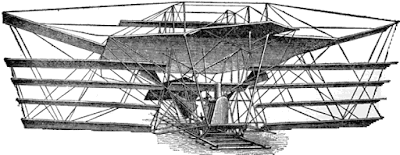 |
| Sir Hiram Maxim's Carnival Ride and Aircraft Test Stand - Reported to be one of the few original ones still in use. |
In 1881, Maxim arrived in Britain to reorganize the London offices of the United States Electric Lighting Company and found the country to his liking. Several years later he became a naturalized British citizen while retaining his American citizenship.
The story is that in 1882 he was told by an American, “If you want to make a pile of money, invent something that will enable these Europeans to cut each others' throats with greater facility.” And that led to thoughts of rapid fire.
After moving to England he settled in a house with I presume a large yard, in West Norwood where he developed his design for an automatic weapon, using a mechanism that would close the breech and compress a spring to store the recoil energy released by the previous shot to advance the gun for its next shot. From 1883 through 1885 Maxim patented gas, recoil and blowback methods of operation. He thoughtfully ran announcements in the local press warning that he would be experimenting with the gun in his garden and that neighbors should keep their windows open to avoid the danger of broken glass.
To improve the machine gun’s efficiency, he developed his own smokeless powder, cordite, a double-base powder containing nitrocellulose, nitroglycerin and a stabilizer. Some men love the smell of napalm in the morning, but for me, its cordite.
There is a certain irony that his son, Percy, invented the Maxim Silencer, the first commercially successful firearm sound suppressor, but too late to save his father’s hearing. Percy’s design was different than modern suppressors, it used curved vanes to force expanding gasses to spin in little vortices inside the device, cooling and reducing their pressure. The suppressor was designed for rifles and had an off-center attachment which allowed stock iron sights to be used.
After the success of his machine gun Maxim turned his interest to flying. It was a time of a wild, wild west competition between lighter and heavier than air machines. At the time the science of aeronautics was barely off the ground. Inventors almost always had to start from scratch. Before starting design work, Maxim carried out a series of experiments on wing cross-sections and propeller design, using a wind tunnel he designed and built and later a whirling arm test rig. This rig became a children’s ride, but having controllable rudders and wings under the control of children was found to be too dangerous. Rudderless versions were made and most of us have ridden on one. They were just a simple seat in a cylinder hanging from chains swung in a circle. Usually there was a wheel to turn to help engage the child.
 |
| Mad Maximum Max's Machine -The Leviathan |
Maxim built the plane as a test rig, a proof of concept, if you will and it ran on a 1,800-foot length of rail track in his backyard. To prevent the machine lifting off, heavy cast-iron wheels were used, but Maxim worried that was insufficient. The machine was fitted with four wheeled outriggers which were restrained by wooden rails. During a test in 1894 with Maxim at the controls and a two man crew, the machine lifted and all the outriggers were engaged, showing that it had developed enough lift to take off. It was the first tethered flight of a heavier-than-air. "I found myself floating in the air with the feeling of being in a boat." Maxim said
But something changed. Maxim reached over and closed the valve on the fuel line and walked away from powered flight.
Maxim was knighted in 1901 and passed on in November of 1916 while his machine guns were still chattering away during WWI changing combat was it was understood.
Comments
Post a Comment